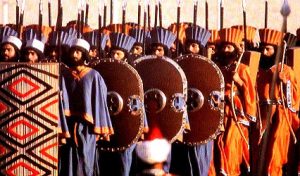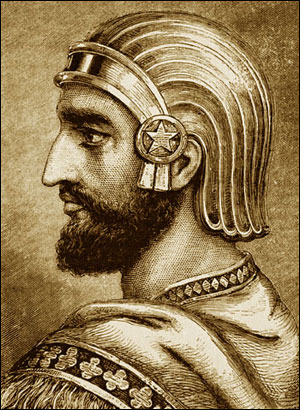The early military machine of Cyrus the Great wasn’t what you would think it was… it wasn’t professional by any means. In fact, when Cyrus set out against Media he relied more on friends and kinsmen from local tribes, who united due to the troubled times. When it was over, these ‘soldiers’ returned to their own homes and pastures, leaving Cyrus with almost nothing.
 Instead, the professional and conquering army of Cyrus would not come until later, when he had conquered Media… and even then it would take some time for it to really come together. Once it had, however, Cyrus had a great army, which would continue through his successors.
Instead, the professional and conquering army of Cyrus would not come until later, when he had conquered Media… and even then it would take some time for it to really come together. Once it had, however, Cyrus had a great army, which would continue through his successors. But the question is… what made them great?
To answer this, we must take a deeper look into the military apparatus of the Persian army. Only then we may be able to understand why they were able to conquer such a vast and diverse territory.
To begin with, there were ‘the Immortals’, a fearsome army of 10,000 men that was created by Cyrus the Great. They were recruited from the lower classes of Persia to serve as the king’s personal bodyguard day and night. Wherever the king went, so did they.
 There were 10,000 men at all times. If, for any reason, one of these soldiers fell ill, wounded, or even died, he was immediately replaced to ensure that the number of guards was always at 10,000.
There were 10,000 men at all times. If, for any reason, one of these soldiers fell ill, wounded, or even died, he was immediately replaced to ensure that the number of guards was always at 10,000. Hence the name ‘Immortals’.
Additionally, they kept silent when marching in mass. Imagine this eerie scene for one moment. You are facing these fighting machines from the other end of the battlefield, when all you feel is the earth tremble slightly under your feet. A whole army of silence approaches you, quickly advancing. Back then, it was common for most warriors to scream and shout when in combat in order to intimidate their opponent. The Immortals did the exact opposite. They killed them with silence.
Besides this elite royal guard, there was the cavalry. In the early days, they made up only 10% of Cyrus’ entire army, while the other 90% was infantry, or foot soldiers. As time went on, however, Cyrus started to notice the importance and the effectiveness of cavalry forces, and so increased their ratio to 20%
This additional cavalry was light, carrying only a bow. Moreover, the men were mainly of non-Persian ethnicity, though they were commanded, for the most part, by Persian officers. Their duty was to harass the enemy with a barrage of arrows and draw them into an attack. A hit and run approach that would be annoying to any attacker.
Persian nobles formed the heavy cavalry. They were armed with two javelins, a wooden or metal lance and they carried an akinakes as well as a small oval shield. The armor of a heavy cavalryman was of leather, overlapped with metal disks such as bronze, iron, and gold, and was often colored in order to distinguish one unit from another.
Persian infantry varied between light and heavy. The light units carried spear and swords, while their heavier counterparts bore a longer spear, a shorter sword and a battle-axe. These heavier infantry wore black hoods that covered their head and much of their face.
 Alongside the cavalry and infantry units, there were the charioteer units. The Persian chariot was slightly higher and heavier than its Assyrian, Egyptian and Babylonian equivalents, requiring four horses to pull it, instead of the standard two. Moreover, these chariots had the ability to carry an extra man; one drove the cumbersome vehicle while the other passenger was a soldier, either a spearman or an archer. To make it even more destructive, Cyrus had scythes installed on the axle, which extended two yards out from the wheel.
Alongside the cavalry and infantry units, there were the charioteer units. The Persian chariot was slightly higher and heavier than its Assyrian, Egyptian and Babylonian equivalents, requiring four horses to pull it, instead of the standard two. Moreover, these chariots had the ability to carry an extra man; one drove the cumbersome vehicle while the other passenger was a soldier, either a spearman or an archer. To make it even more destructive, Cyrus had scythes installed on the axle, which extended two yards out from the wheel. Overall, it was a deadly machine, but only when it was able to grace the battlefield, as no charioteer, or for that matter horse, would plow into a forest of spear points and shields. Instead the chariot was more effective against light infantry, loose formations, and troops of undisciplined men unwilling to stand their ground in the face of combat.
In addition to archers, charioteers and spearmen, there was a very unlikely group that was of great importance to the army: combat engineers. These men would move ahead of the advancing forces to repair or build roads and bridges. They would dig ditches or used pontoon boats as floats for bridges to get the massive and heavy army across.
In fact, to transport this huge army was a feat in itself. The Persians, with all their ingenuity and complexity of their military system, still had to have a supply line able to accommodate this giant juggernaut when on the move.
 The job in supplying the Persian army was left to the commissariat. While in transit, the commissariat was split into two, one in front of the army and the other at the back. The commissariat that moved ahead was tasked with finding suitable places to encamp, with clean water and fields for their livestock to graze. The rear commissariat, on the other hand, had to keep the army supplied with all types of weaponry, such as bows, swords, spears, arrows, armor, among others.
The job in supplying the Persian army was left to the commissariat. While in transit, the commissariat was split into two, one in front of the army and the other at the back. The commissariat that moved ahead was tasked with finding suitable places to encamp, with clean water and fields for their livestock to graze. The rear commissariat, on the other hand, had to keep the army supplied with all types of weaponry, such as bows, swords, spears, arrows, armor, among others. Now, due to the amount of equipment the commissariat needed, it was inevitable that they would eventually run out. In order to solve this problem, the Persian king required that each satrap, or governor, keep a certain amount of supply on hand for the incoming army, so it could restock before the next big move.
The Persian army was truly a professional fighting force of a complex magnitude that in many ways would not be matched until the Macedonian and Roman Empires.
However, with their professionalism, also came their weakness. As stated before, they were complex. Those in their ranks were from diverse backgrounds and educations, and most importantly, not skilled in same weapons.
But Persia did well with this standing army. Most of the regions under Persian control had only a hodgepodge of military units, many of which were light infantry, such as archers and spearmen, with little to no armor whatsoever.
The Persians, therefore, relied on quantity over quality in its military ranks. It succeeded in the region of the world they were in, but as time went on, they would face armies who were all about amour and standard structure. Armies that were small in comparison, but undoubtedly more disciplined.
That is where their true challenge would lay….
Read Part One: ‘Cyrus the Great’ Here.









One comment
Great Explanation…
I would be happy to read more history in short versions like this one.
Our apologies, you must be logged in to post a comment.